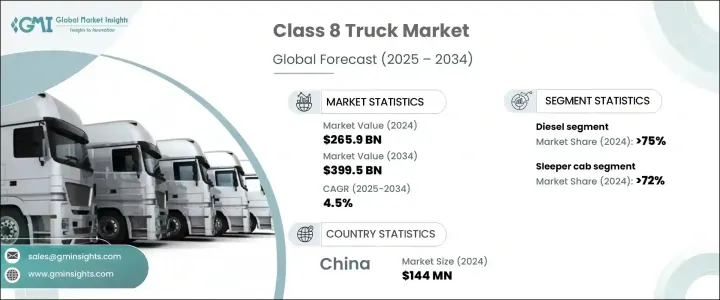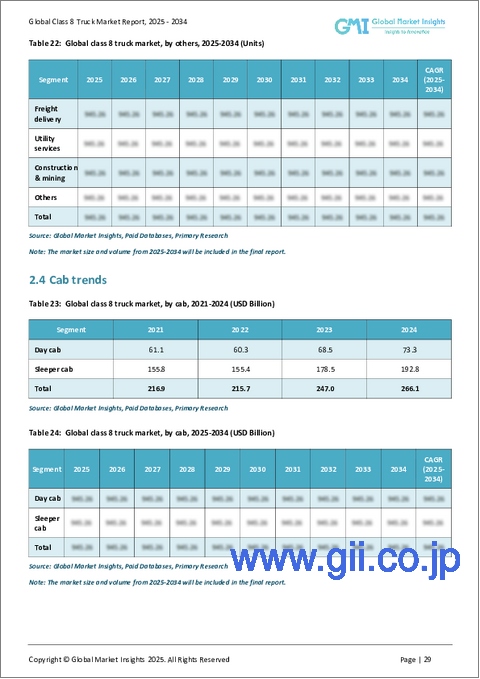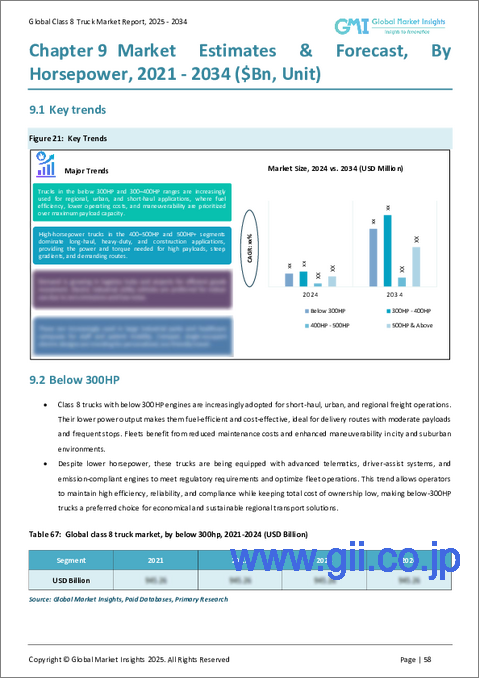|
|
市場調査レポート
商品コード
1698601
クラス8トラック市場の機会、成長促進要因、産業動向分析、2025年~2034年の予測Class 8 Truck Market Opportunity, Growth Drivers, Industry Trend Analysis, and Forecast 2025-2034 |
||||||
カスタマイズ可能
|
|||||||
| クラス8トラック市場の機会、成長促進要因、産業動向分析、2025年~2034年の予測 |
|
出版日: 2025年02月14日
発行: Global Market Insights Inc.
ページ情報: 英文 180 Pages
納期: 2~3営業日
|
全表示
- 概要
- 目次
クラス8トラックの世界市場は、2024年に2,659億米ドルの評価額に達し、2025年から2034年にかけてCAGR 4.5%で成長すると予測されています。
市場の拡大には、国際貿易の増加、インフラ開拓、効率的な貨物輸送に対する需要の高まりが寄与しています。貿易政策の自由化と国境を越えた連結性の取り組みが、ロジスティクスとサプライチェーン業務をサポートする高性能トラックの必要性を高めています。拡大する産業部門と世界なeコマースの台頭は需要をさらに増幅し、高度なトラック輸送ソリューションへのより高い投資をもたらしています。

最新技術の統合は業界を変革しており、フリート・オペレーターは自律走行システム、テレマティックス、および効率改善と運用コスト削減のための高度な安全機能を採用しています。フリート最適化とドライバーの安全性に対する期待の高まりは、事業者に最先端機能を備えた車両への投資を促し、市場競争と技術進歩を加速させています。業界各社は、進化する環境規制や物流要件に対応するため、車両設計、燃費効率、持続可能性の向上に注力しています。
| 市場範囲 | |
|---|---|
| 開始年 | 2024 |
| 予測年 | 2025-2034 |
| 開始金額 | 2,659億米ドル |
| 予測金額 | 3,995億米ドル |
| CAGR | 4.5% |
市場は、ディーゼル、天然ガス、ハイブリッド電気モデルなど、燃料タイプに基づいて区分されます。2024年には、ディーゼルエンジン搭載トラックが市場シェア全体の75%以上を占める。これらの車両は、その耐久性、高トルク出力、頻繁な燃料補給なしで長距離を走行できる能力により、依然として好ましい選択肢となっています。大型貨物輸送、建設、その他の産業用途は、確立された燃料補給インフラに支えられ、引き続きディーゼルエンジンに大きく依存しています。業界は徐々に代替燃料にシフトしつつあるが、ディーゼル・トラックはその信頼性と費用対効果の高さにより、市場の強い優位性を維持しています。
車両形態では、市場はデイキャブとスリーパーキャブに分けられます。2024年には、長距離輸送需要の高まりにより、寝台キャブが市場全体の72%以上を占める。これらのトラックはドライバーに快適な休息空間を提供し、企業が義務付けられた休息時間を遵守し、労働力の維持を改善するのに役立ちます。先進的な寝台キャブ・モデルには、車線逸脱警告、アダプティブ・クルーズ・コントロール、死角検出などの安全技術が統合されており、運行の安全性と効率を高めています。
地域別では、アジア太平洋地域が大きな成長を遂げており、中国が2024年に約1億4,400万米ドルの売上を生み出し、この分野をリードしています。急速な都市化、経済拡大、主要国でのインフラ投資の増加は、クラス8トラックに対する需要の高まりに寄与しています。物流ネットワークとeコマース事業の拡大は、効率的な輸送システムの必要性をさらに押し上げています。工業生産高の増加と政府の支援によるインフラ・プロジェクトは、貨物車に対する需要が引き続き堅調であることを保証し、この地域を世界のクラス8トラック市場における主要な成長ハブとして位置づけています。
目次
第1章 調査手法と調査範囲
- 調査デザイン
- 調査アプローチ
- データ収集方法
- 基本推定と計算
- 基準年の算出
- 市場推計の主要動向
- 予測モデル
- 1次調査と検証
- 市場定義
第2章 エグゼクティブサマリー
第3章 業界洞察
- エコシステム分析
- サプライヤーの状況
- 原材料サプライヤー
- 部品サプライヤー
- メーカー
- サービス・プロバイダー
- 流通チャネル
- 最終用途
- 利益率分析
- 技術とイノベーションの展望
- 特許分析
- 主要ニュース&イニシアティブ
- 規制状況
- 影響要因
- 促進要因
- クラス8トラックにおける自律走行技術への需要の高まり
- クラス8トラックの利用率を高める長距離貨物活動の増加
- 厳しい規制による高度な排ガス制御システムの導入
- 物流ネットワークとeコマースの世界的拡大
- トラック輸送の効率性と安全機能における技術的進歩
- 業界の潜在的リスク&課題
- 先端技術統合の高コスト
- 貨物需要に影響する経済減速
- 促進要因
- 成長可能性分析
- ポーター分析
- PESTEL分析
第4章 競合情勢
- イントロダクション
- 企業シェア分析
- 競合のポジショニング・マトリックス
- 戦略展望マトリックス
第5章 市場推計・予測:燃料別、2021年~2034年
- 主要動向
- ディーゼル
- 貨物輸送
- 公益事業
- 建設・鉱業
- その他
- 天然ガス
- 貨物輸送
- 公益事業
- 建設・鉱業
- その他
- ハイブリッド電気
- 貨物輸送
- 公益事業
- 建設・鉱業
- その他
- その他
- 貨物輸送
- 公益事業
- 建設・鉱業
- その他
第6章 市場推計・予測:キャブ別、2021年~2034年
- 主要動向
- デイキャブ
- スリーパーキャブ
第7章 市場推計・予測:用途別、2021年~2034年
- 主要動向
- 貨物輸送
- ユーティリティサービス
- 建設・鉱業
- その他
第8章 市場推計・予測:車軸別、2021年~2034年
- 主要動向
- 4x2
- 6x4
- 6x2
第9章 市場推計・予測:馬力別、2021年~2034年
- 主要動向
- 300HP未満
- 300HP-400HP
- 400HP-500HP
- 500HP以上
第10章 市場推計・予測:所有者別、2021年~2034年
- 主要動向
- フリートオペレーター
- 独立系オペレーター
第11章 市場推計・予測:地域別、2021年~2034年
- 主要動向
- 北米
- 米国
- カナダ
- 欧州
- 英国
- ドイツ
- フランス
- イタリア
- ロシア
- ベルギー
- スウェーデン
- アジア太平洋
- 中国
- インド
- 日本
- 韓国
- インドネシア
- タイ
- ベトナム
- ラテンアメリカ
- ブラジル
- メキシコ
- アルゼンチン
- 中東・アフリカ
- 南アフリカ
- アラブ首長国連邦
- サウジアラビア
- イラン
- トルコ
第12章 企業プロファイル
- Dongfeng
- Eicher
- Ford
- Freightliner
- GMC(General Motors Truck Company)
- Hino
- International Truck(Navistar)
- Isuzu
- Kenworth
- Mack Trucks
- MAN SE
- Mitsubishi Fuso Truck and Bus Corporation
- Peterbilt
- Scania
- Volvo
The Global Class 8 Truck Market reached a valuation of USD 265.9 billion in 2024 and is projected to grow at a CAGR of 4.5% between 2025 and 2034. Market expansion is fueled by increasing international trade, infrastructure development, and growing demand for efficient freight transportation. The liberalization of trade policies and cross-border connectivity initiatives have driven the need for high-performance trucks to support logistics and supply chain operations. Expanding industrial sectors and the rise of global e-commerce are further amplifying demand, leading to higher investments in advanced trucking solutions.

The integration of modern technologies is transforming the industry, with fleet operators adopting autonomous driving systems, telematics, and advanced safety features to improve efficiency and reduce operational costs. Rising expectations for fleet optimization and driver safety encourage businesses to invest in vehicles equipped with cutting-edge capabilities, accelerating market competition and technological advancements. Industry players are focused on enhancing vehicle design, fuel efficiency, and sustainability to align with evolving environmental regulations and logistics requirements.
| Market Scope | |
|---|---|
| Start Year | 2024 |
| Forecast Year | 2025-2034 |
| Start Value | $265.9 Billion |
| Forecast Value | $399.5 Billion |
| CAGR | 4.5% |
The market is segmented based on fuel types, including diesel, natural gas, and hybrid electric models. In 2024, diesel-powered trucks accounted for more than 75% of the total market share. These vehicles remain the preferred choice due to their durability, high torque output, and ability to cover long distances without frequent refueling. Heavy-duty freight transport, construction, and other industrial applications continue to rely heavily on diesel engines, supported by a well-established refueling infrastructure. While the industry is gradually shifting toward alternative fuels, diesel trucks maintain strong market dominance due to their reliability and cost-effectiveness.
In terms of vehicle configuration, the market is divided into day cab and sleeper cab variants. In 2024, sleeper cabs represented over 72% of the total market, driven by the growing demand for long-haul transportation. These trucks provide drivers with comfortable resting spaces, helping companies comply with mandated rest periods and improving workforce retention. Advanced sleeper cab models come with integrated safety technologies such as lane departure warning, adaptive cruise control, and blind spot detection, enhancing operational safety and efficiency.
Regionally, the Asia-Pacific sector is experiencing significant growth, with China leading the segment, generating approximately USD 144 million in revenue in 2024. Rapid urbanization, economic expansion, and increasing infrastructure investments across major economies contribute to heightened demand for Class 8 trucks. The expansion of logistics networks and e-commerce businesses is further pushing the need for efficient transportation systems. Rising industrial output and government-backed infrastructure projects ensure that demand for freight vehicles remains strong, positioning the region as a key growth hub in the global Class 8 truck market.
Table of Contents
Chapter 1 Methodology & Scope
- 1.1 Research design
- 1.1.1 Research approach
- 1.1.2 Data collection methods
- 1.2 Base estimates and calculations
- 1.2.1 Base year calculation
- 1.2.2 Key trends for market estimates
- 1.3 Forecast model
- 1.4 Primary research & validation
- 1.4.1 Primary sources
- 1.4.2 Data mining sources
- 1.5 Market definitions
Chapter 2 Executive Summary
- 2.1 Industry 3600 synopsis, 2021 - 2034
Chapter 3 Industry Insights
- 3.1 Industry ecosystem analysis
- 3.2 Supplier landscape
- 3.2.1 Raw material suppliers
- 3.2.2 Component suppliers
- 3.2.3 Manufacturers
- 3.2.4 Service providers
- 3.2.5 Distribution channel
- 3.2.6 End Use
- 3.3 Profit margin analysis
- 3.4 Technology & innovation landscape
- 3.5 Patent analysis
- 3.6 Key news & initiatives
- 3.7 Regulatory landscape
- 3.8 Impact forces
- 3.8.1 Growth drivers
- 3.8.1.1 Escalating demand for autonomous driving technologies in class 8 trucks
- 3.8.1.2 Increasing long-haul freight activities bolstering class 8 truck utilization
- 3.8.1.3 Introduction of advanced emission control systems due to strict regulations
- 3.8.1.4 Expansion of logistic networks and e-commerce globally
- 3.8.1.5 Technological advancements in trucking efficiency and safety features
- 3.8.2 Industry pitfalls & challenges
- 3.8.2.1 High cost of advanced technology integration
- 3.8.2.2 Economic slowdown affecting freight demand
- 3.8.1 Growth drivers
- 3.9 Growth potential analysis
- 3.10 Porter's analysis
- 3.11 PESTEL analysis
Chapter 4 Competitive Landscape, 2024
- 4.1 Introduction
- 4.2 Company market share analysis
- 4.3 Competitive positioning matrix
- 4.4 Strategic outlook matrix
Chapter 5 Market Estimates & Forecast, By Fuel, 2021 - 2034 ($Mn & Units)
- 5.1 Key trends
- 5.2 Diesel
- 5.2.1 Freight delivery
- 5.2.2 Utility services
- 5.2.3 Construction & mining
- 5.2.4 Others
- 5.3 Natural gas
- 5.3.1 Freight delivery
- 5.3.2 Utility services
- 5.3.3 Construction & mining
- 5.3.4 Others
- 5.4 Hybrid electric
- 5.4.1 Freight delivery
- 5.4.2 Utility services
- 5.4.3 Construction & mining
- 5.4.4 Others
- 5.5 Others
- 5.5.1 Freight delivery
- 5.5.2 Utility services
- 5.5.3 Construction & mining
- 5.5.4 Others
Chapter 6 Market Estimates & Forecast, By Cab, 2021 - 2034 ($Mn & Units)
- 6.1 Key trends
- 6.2 Day cab
- 6.3 Sleeper cab
Chapter 7 Market Estimates & Forecast, By Application, 2021 - 2034 ($Mn & Units)
- 7.1 Key trends
- 7.2 Freight delivery
- 7.3 Utility services
- 7.4 Construction & mining
- 7.5 Others
Chapter 8 Market Estimates & Forecast, By Axle, 2021 - 2034 ($Mn & Units)
- 8.1 Key trends
- 8.2 4x2
- 8.3 6x4
- 8.4 6x2
Chapter 9 Market Estimates & Forecast, By Horsepower, 2021 - 2034 ($Mn & Units)
- 9.1 Key trends
- 9.2 Below 300HP
- 9.3 300HP - 400HP
- 9.4 400HP - 500HP
- 9.5 500HP & Above
Chapter 10 Market Estimates & Forecast, By Ownership, 2021 - 2034 ($Mn & Units)
- 10.1 Key trends
- 10.2 Fleet operator
- 10.3 Independent operator
Chapter 11 Market Estimates & Forecast, By Region, 2021 - 2034 ($Mn & Units)
- 11.1 Key trends
- 11.2 North America
- 11.2.1 U.S.
- 11.2.2 Canada
- 11.3 Europe
- 11.3.1 UK
- 11.3.2 Germany
- 11.3.3 France
- 11.3.4 Italy
- 11.3.5 Russia
- 11.3.6 Belgium
- 11.3.7 Sweden
- 11.4 Asia Pacific
- 11.4.1 China
- 11.4.2 India
- 11.4.3 Japan
- 11.4.4 South Korea
- 11.4.5 Indonesia
- 11.4.6 Thailand
- 11.4.7 Vietnam
- 11.5 Latin America
- 11.5.1 Brazil
- 11.5.2 Mexico
- 11.5.3 Argentina
- 11.6 MEA
- 11.6.1 South Africa
- 11.6.2 UAE
- 11.6.3 Saudi Arabia
- 11.6.4 Iran
- 11.6.5 Turkey
Chapter 12 Company Profiles
- 12.1 Dongfeng
- 12.2 Eicher
- 12.3 Ford
- 12.4 Freightliner
- 12.5 GMC (General Motors Truck Company)
- 12.6 Hino
- 12.7 International Truck (Navistar)
- 12.8 Isuzu
- 12.9 Kenworth
- 12.10 Mack Trucks
- 12.11 MAN SE
- 12.12 Mitsubishi Fuso Truck and Bus Corporation
- 12.13 Peterbilt
- 12.14 Scania
- 12.15 Volvo






